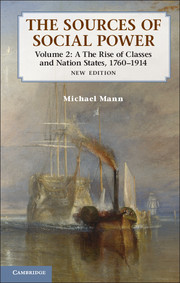Book contents
- Frontmatter
- Contents
- Preface to the new edition
- Preface
- 1 Introduction
- 2 Economic and ideological power relations
- 3 A theory of the modern state
- 4 The Industrial Revolution and old regime liberalism in Britain, 1760–1880
- 5 The American Revolution and the institutionalization of confederal capitalist liberalism
- 6 The French Revolution and the bourgeois nation
- 7 Conclusion to Chapters 4–6: The emergence of classes and nations
- 8 Geopolitics and international capitalism
- 9 Struggle over Germany: I. Prussia and authoritarian national capitalism
- 10 Struggle over Germany: II. Austria and confederal representation
- 11 The rise of the modern state: I. Quantitative data
- 12 The rise of the modern state: II. The autonomy of military power
- 13 The rise of the modern state: III. Bureaucratization
- 14 The rise of the modern state: IV. The expansion of civilian scope
- 15 The resistible rise of the British working class, 1815–1880
- 16 The middle-class nation
- 17 Class struggle in the Second Industrial Revolution, 1880–1914: I. Great Britain
- 18 Class struggle in the Second Industrial Revolution, 1880–1914: II. Comparative analysis of working-class movements
- 19 Class struggle in the Second Industrial Revolution, 1880–1914: III. The peasantry
- 20 Theoretical conclusions: Classes, states, nations, and the sources of social power
- 21 Empirical culmination – over the top: Geopolitics, class struggle, and World War I
- Appendix: Additional tables on state finances and state employment
- Index
- References
17 - Class struggle in the Second Industrial Revolution, 1880–1914: I. Great Britain
Published online by Cambridge University Press: 05 July 2013
- Frontmatter
- Contents
- Preface to the new edition
- Preface
- 1 Introduction
- 2 Economic and ideological power relations
- 3 A theory of the modern state
- 4 The Industrial Revolution and old regime liberalism in Britain, 1760–1880
- 5 The American Revolution and the institutionalization of confederal capitalist liberalism
- 6 The French Revolution and the bourgeois nation
- 7 Conclusion to Chapters 4–6: The emergence of classes and nations
- 8 Geopolitics and international capitalism
- 9 Struggle over Germany: I. Prussia and authoritarian national capitalism
- 10 Struggle over Germany: II. Austria and confederal representation
- 11 The rise of the modern state: I. Quantitative data
- 12 The rise of the modern state: II. The autonomy of military power
- 13 The rise of the modern state: III. Bureaucratization
- 14 The rise of the modern state: IV. The expansion of civilian scope
- 15 The resistible rise of the British working class, 1815–1880
- 16 The middle-class nation
- 17 Class struggle in the Second Industrial Revolution, 1880–1914: I. Great Britain
- 18 Class struggle in the Second Industrial Revolution, 1880–1914: II. Comparative analysis of working-class movements
- 19 Class struggle in the Second Industrial Revolution, 1880–1914: III. The peasantry
- 20 Theoretical conclusions: Classes, states, nations, and the sources of social power
- 21 Empirical culmination – over the top: Geopolitics, class struggle, and World War I
- Appendix: Additional tables on state finances and state employment
- Index
- References
Summary
The Second Industrial Revolution
Between 1880 and 1914, most Western countries experienced their most rapid economic growth. (See Tables 8.2 and 8.4.) Agriculture was transformed, and migration from agriculture to the towns and overseas reached its highest levels. The “Second Industrial Revolution” brought big capital, high science, and complex technology especially into three industries – iron and steel, metal manufacturing, and chemicals. Agrarian and industrial commodities were distributed nationally by rail and internationally by steamships. Banks and stock markets channeled savings into global investment and then back as profits to enhance consumption. Thus the second revolution advanced the integration of economies, though their totality remained ambiguous because dual – national and transnational.
This second revolution in economic power changed societies. Collective powers were transformed qualitatively. Mass living standards throughout the West began to rise and remain securely above mere subsistence. Thus life expectancy began its dramatic, rapid rise, from about forty years in 1870 – which might have represented only the high point of yet another Malthusianlike historical cycle – to about seventy years by 1950. The life expectancy of women exceeded that of men. Societies became urbanized and industrialized. All this may have represented the most profound social change the world had ever seen. It resulted primarily from a revolution in economic power relations, from the industrializing phase of capitalism. Throughout this period, there has to be a residual economic determinism in our theories.
- Type
- Chapter
- Information
- The Sources of Social Power , pp. 597 - 627Publisher: Cambridge University PressPrint publication year: 2012



